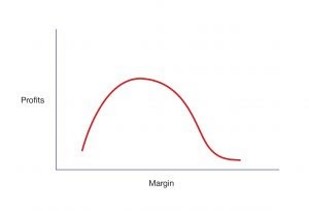Calculating Margins
Online travel agencies operate using a very interesting business model. They have no inventory or product of their own, and profit by adding on a commission to the prices provided to them by airlines, hotels, and other travel-related service providers.
The commission essentially acts as their margin. The higher the commission, the higher profits. While the model sounds easy enough, calculating the exact commission level to maximize profits is anything but simple.
Markdown Optimization
These online travel agencies operate in a highly competitive environment. Travelers often compare prices between multiple browser windows, looking for the best price for their trip. As shown in this chart, your typical online travel agency will find that the probability of having a customer conversion decreases as margins increase.


Travel agents then need to calculate their profit levels at different commission levels. Low commissions, which would increase the probability of conversion, would deliver lower profits, while high commissions would decrease the likelihood of conversions. Through testing various commission levels, online travel agents can find the optimal commission level to maximize profits.
Pricing Testing
While performing commission testing, some online travel agencies find a surprising profit curve. Rather than have a single optimal price, they find two high-profit price points at very different margins. This can happen
in instances where a large, mass market group prefers a lower price, while a small, high-end section of people prefer to pay more. In this circumstance, online agencies may be best off splitting their offering into a high- and low-end brand, to accommodate both populations.

How AI-Pricing Can Help?
In all these circumstances, online travel agents are best off using a dynamic pricing engine to identify the right commission point. The pricing engine evaluates competitor pricing, factors in internal pricing strategy decisions, and ac
counts for consumer behavior. Using the available information, dynamic pricing engines can test dozens of different commission levels and learn from past behavior and conversions to determine the right commission percentage for each trip.
Dynamic pricing engines also allow for online travel agencies to develop a consistent pricing strategy, rather than rely on manual processes to react to the ongoing changes within the competitive market. The engine’s continuous monitoring, coupled with machine learning and artificial intelligence, ensures that an online travel agent’s commission level puts them in the best position to convert web traffic into reservations and bookings.










